Search Result
Results for "
S��n Inhibitors
" in MedChemExpress (MCE) Product Catalog:
2
Biochemical Assay Reagents
2
Isotope-Labeled Compounds
| Cat. No. |
Product Name |
Target |
Research Areas |
Chemical Structure |
-
- HY-W013268
-
|
|
Others
|
Metabolic Disease
|
|
(S)-(+)-N-3-Benzylnirvanol is a drug used for
metabolic regulation. (S)-(+)-N-3-Benzylnirvanol has the activity of inhibiting
human P450 enzyme. (S)-(+) -n-3-benzylnirvanol can be used to study drug
interactions during drug metabolism .
|
-
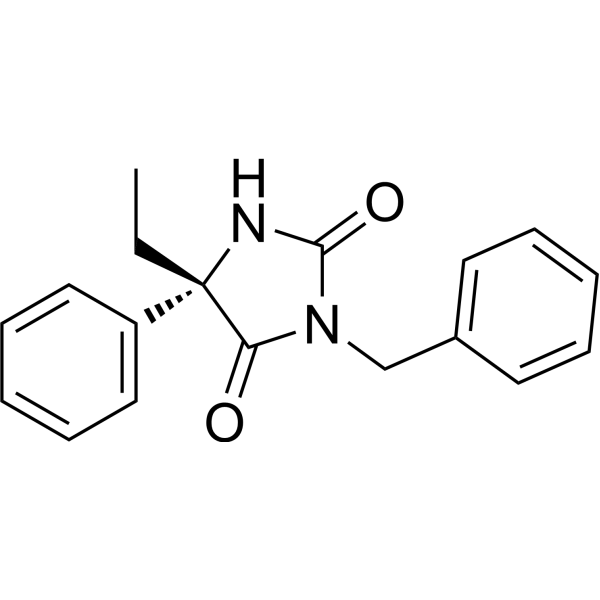
-
- HY-153013
-
|
|
Drug-Linker Conjugates for ADC
|
Cancer
|
|
SN38-COOH is used for the synthesis of antibody-drug conjugates (ADCs). SN-38 is an active metabolite of the Topoisomerase I inhibitor Irinotecan. SN-38 inhibits DNA and RNA synthesis .
|
-

-
- HY-13704S
-
|
NK012-d3
|
Topoisomerase
ADC Cytotoxin
Autophagy
|
Cancer
|
|
SN-38-d3 is the deuterium labeled SN-38. SN-38 (NK012) is an active metabolite of the Topoisomerase I inhibitor Irinotecan. SN-38 (NK012) inhibits DNA and RNA synthesis with IC50s of 0.077 and 1.3 μM, respectively[1][2][3][4].
|
-

-
- HY-13704
-
SN-38
Maximum Cited Publications
33 Publications Verification
7-Ethyl-10-hydroxycamptothecin
|
Topoisomerase
ADC Cytotoxin
Autophagy
|
Cancer
|
|
SN-38 is an active metabolite of the Topoisomerase I inhibitor Irinotecan. SN-38 inhibits DNA and RNA synthesis with IC50s of 0.077 and 1.3 μM, respectively .
|
-
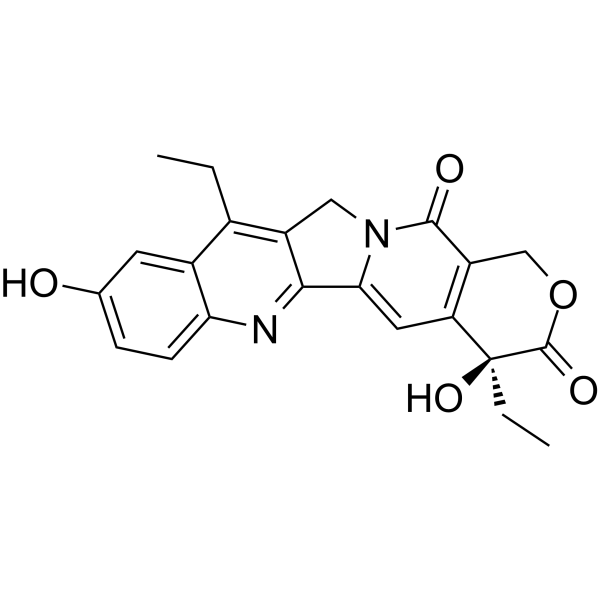
-
- HY-145513
-
|
|
Topoisomerase
|
Cancer
|
|
CL2-MMT-SN38 is a SN-38 derivative. SN-38, an anticancer agent, is an active metabolite of the Topoisomerase I inhibitor Irinotecan (CPT-11) .
|
-
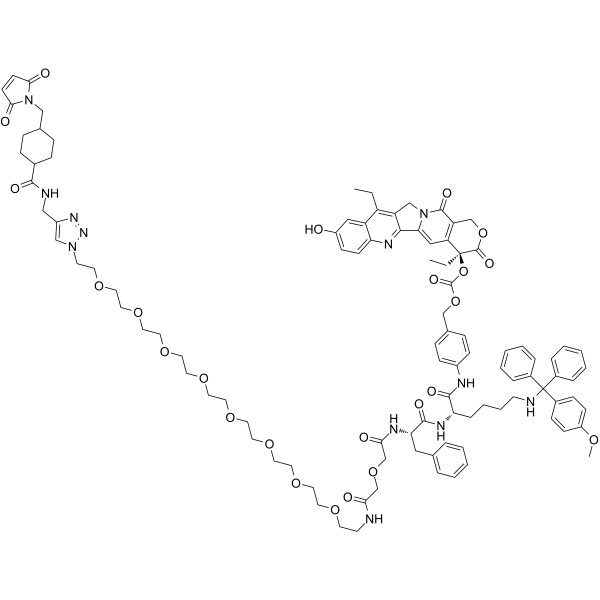
-
- HY-126373S1
-
|
SN-38G-13C6
|
Isotope-Labeled Compounds
|
Others
|
|
SN-38 glucuronide- 13C6 is the 13C labeled SN-38 glucuronide (HY-126373) . SN-38 glucuronide is an inactive metabolite of the cancer agent Irinotecan. Irinotecan is a topoisomerase I inhibitor which can be used for researching colon and rectal cancer .
|
-

-
- HY-145010
-
SN-011
2 Publications Verification
|
STING
|
Inflammation/Immunology
|
|
SN-011 is a potent and selective mouse and human STING inhibitor, with an IC50 of 76 nM for STING signaling. SN-011 competes with cyclic dinucleotide (CDN) for the binding pocket of the STING dimer, blocking CDN binding and STING activation. SN-011 can be used for the research of STING-driven autoimmune and inflammatory disease .
|
-

-
- HY-W140974
-
|
|
STING
|
Cancer
|
|
SN-001 is a STING inhibitor with an IC50 of 3.82 μM .
|
-
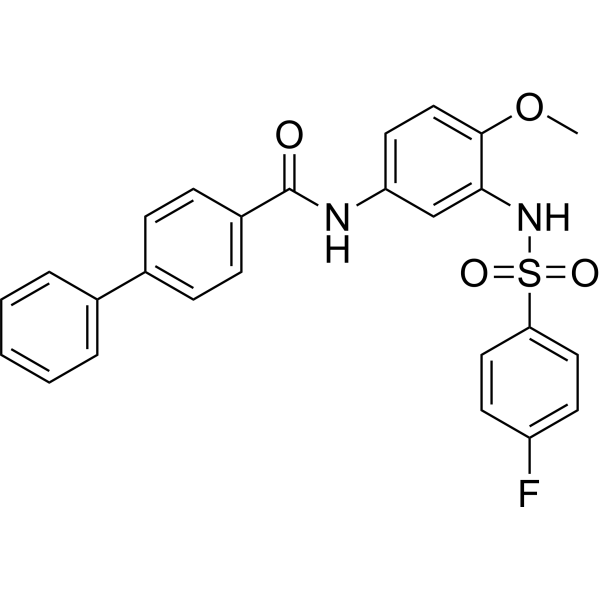
-
- HY-128943
-
|
|
Drug-Linker Conjugates for ADC
|
Cancer
|
|
MAC glucuronide phenol-linked SN-38 is a pH-susceptible lactone MAC glucuronide phenol-linked SN-38 (DNA topoisomerase I inhibitor) agent linker. MAC glucuronide phenol-linked SN-38 is cytotoxic across L540cy cells and Ramos cells with IC50 values of 113 and 67 ng/mL, respectively.Albumin-coupled MAC glucosidol-linked SN-38 shows good stability in mouse plasma .
|
-
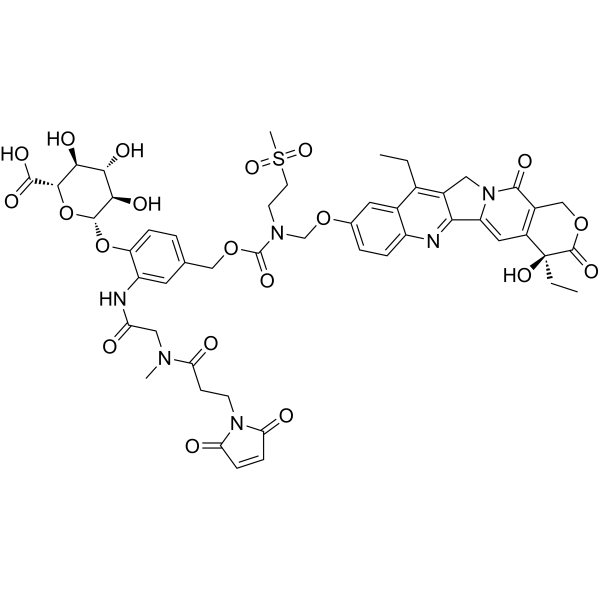
-
- HY-P3229
-
SN52
1 Publications Verification
|
NF-κB
|
Cancer
|
|
SN52 is a potent, competitive, and cell-permeable inhibitor of NF-κB2. SN52 is a variant of the SN50 peptide and inhibits the nuclear translocation of p52-RelB heterodimers. SN52 has a strong radiosensitization effect on prostate cancer cells. SN52 can be used for cancer research .
|
-

-
- HY-115754
-
|
PEITC-Cys
|
DNA/RNA Synthesis
Cytochrome P450
|
Cancer
|
|
S-(N-PhenethylthiocarbaMoyl)-L-cysteine (PEITC-Cys), an anticarcinogenic agent, has antileukemic activity. S-(N-PhenethylthiocarbaMoyl)-L-cysteine inhibits DNA synthesis in HL60 cells . S-(N-PhenethylthiocarbaMoyl)-L-cysteine is a P450 inhibitor .
|
-
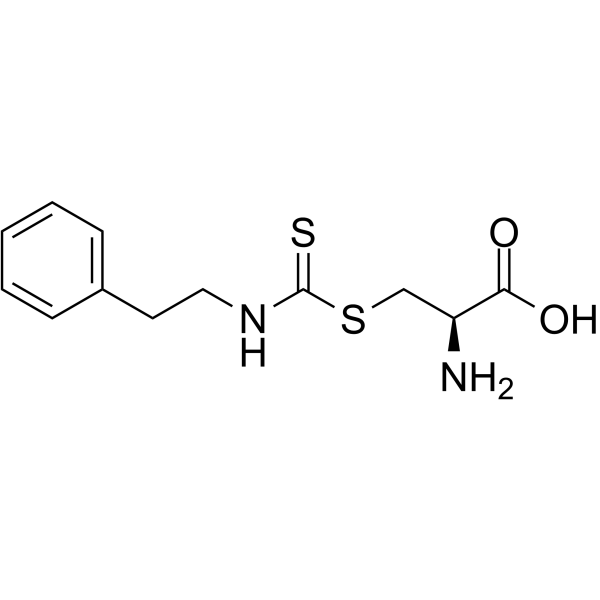
-
- HY-128942
-
|
|
Drug-Linker Conjugates for ADC
|
Cancer
|
|
MAC glucuronide α-hydroxy lactone-linked SN-38 (Topoisomerase I inhibitor) is a stabilized lactone MAC glucuronide α-hydroxy lactone-linked SN-38 agent linker. MAC glucuronide α-hydroxy lactone-linked SN-38 is cytotoxic across L540cy cells and Ramos cells with IC50 values of 99 and 105 ng/mL, respectively .
|
-
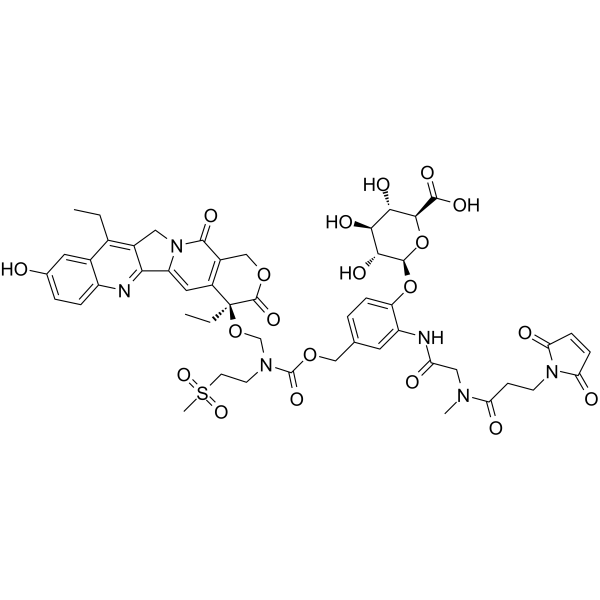
-
- HY-136170
-
|
|
Drug-Linker Conjugates for ADC
|
Cancer
|
|
MC-SN38 is a agent-linker conjugate composed of a potent microtubule-disrupting agent SN38 and a non-cleavable MC linker to make antibody agent conjugate (ADC). SN-38, an active metabolite of the Topoisomerase I inhibitor Irinotecan, inhibits DNA synthesis and causes frequent DNA single-strand breaks .
|
-
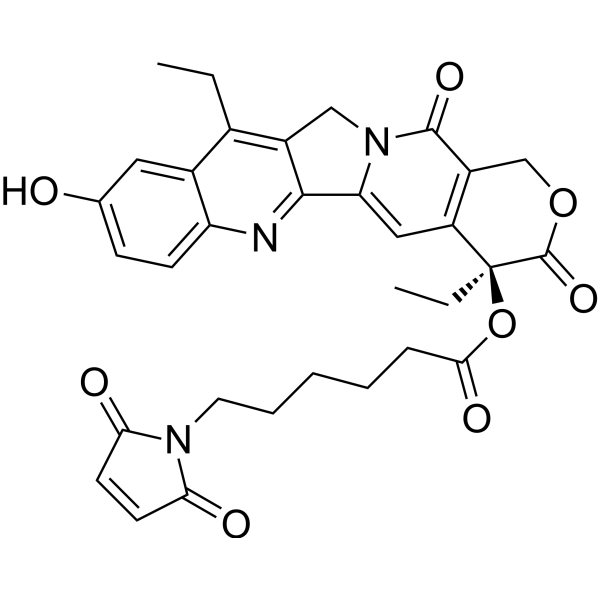
-
- HY-139909
-
|
|
Drug-Linker Conjugates for ADC
|
Cancer
|
|
CL2E-SN-38, a highly releasable and structurally stable antibody-SN-38-conjugate, is a part of the antibody drug conjugate (ADC). SN-38, the active metabolite of Irinotecan from camptothecins, is an Topoisomerase I inhibitor .
|
-

-
- HY-139909A
-
|
|
Drug-Linker Conjugates for ADC
|
Cancer
|
|
CL2E-SN-38 TFA, a highly releasable and structurally stable antibody-SN-38-conjugate, is a part of the antibody drug conjugate (ADC). SN-38, the active metabolite of Irinotecan from camptothecins, is an Topoisomerase I inhibitor .
|
-

-
- HY-131057
-
|
|
Drug-Linker Conjugates for ADC
|
Cancer
|
|
Mc-VC-PAB-SN38 consists a cleavable ADC linker (Mc-VC-PAB) and a DNA topoisomerase I inhibitor (SN38). Mc-VC-PAB-SN38 can be used in the synthesis of antibody-drug conjugates (ADCs) .
|
-
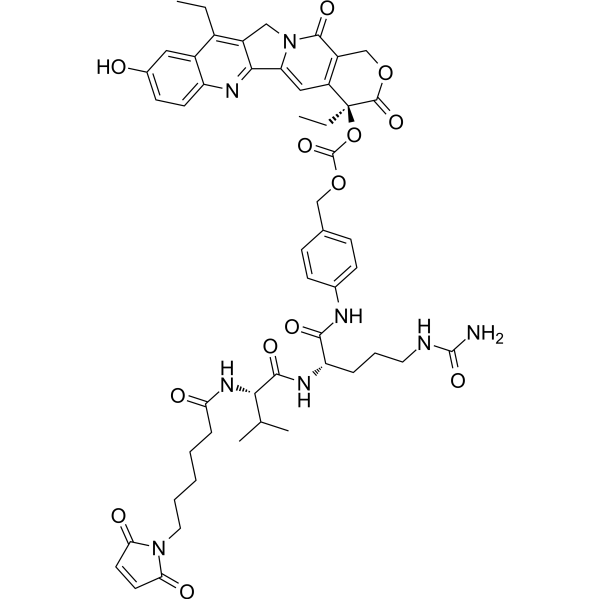
-
- HY-126373
-
|
SN-38G
|
Drug Metabolite
|
Cancer
|
|
SN-38 glucuronide is an inactive metabolite of the cancer agent Irinotecan. Irinotecan is a topoisomerase I inhibitor which can be used for researching colon and rectal cancer .
|
-
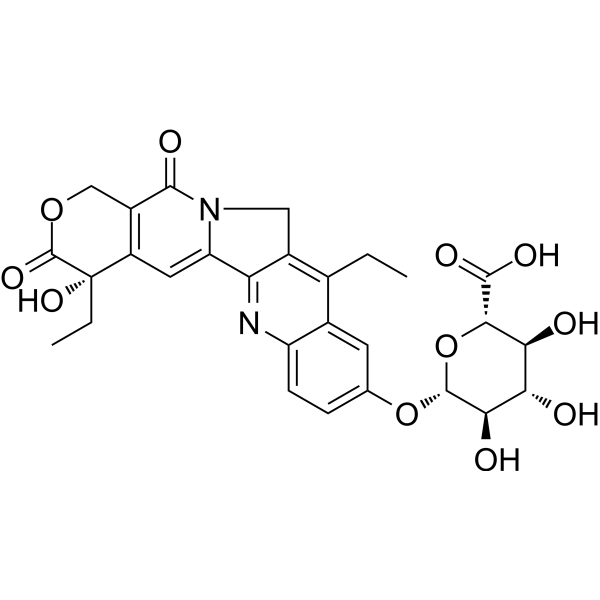
-
- HY-128946
-
|
|
Drug-Linker Conjugates for ADC
|
Inflammation/Immunology
Cancer
|
|
CL2A-SN-38 is a agent-linker conjugate composed of a potent a DNA Topoisomerase I inhibitor SN-38 and a linker CL2A to make antibody agent conjugate (ADC). CL2A-SN-38 provides significant and specific antitumor effects against a range of human solid tumor types. CL2A-SN-38 uses hydrolyzable linker to deliver active agents within tumor cells and in the tumor microenvironment, resulting in bystander effects .
|
-
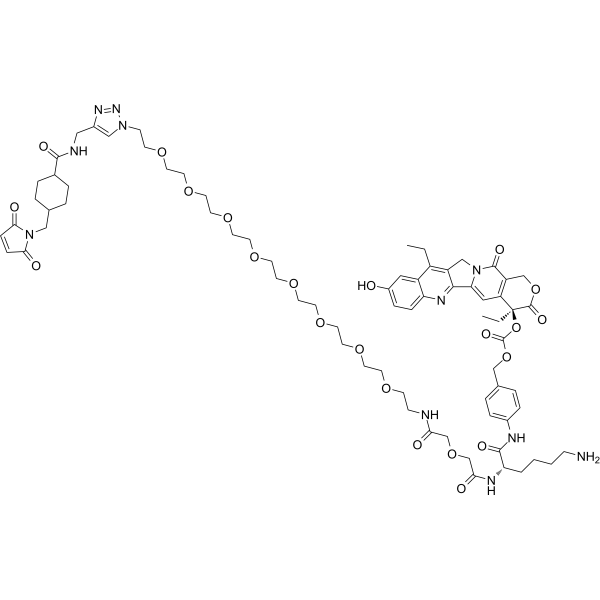
-
- HY-P0151
-
-

-
- HY-16696
-
SN 2
3 Publications Verification
|
Flavivirus
Dengue virus
TRP Channel
|
Infection
|
|
SN 2 is a potent activator of TRPML3 ion channel with an EC50 of 1.8 μM .
SN 2 also acts as a potent inhibitor of Dengue virus 2 (DENV2) and Zika virus (ZIKV) .
|
-
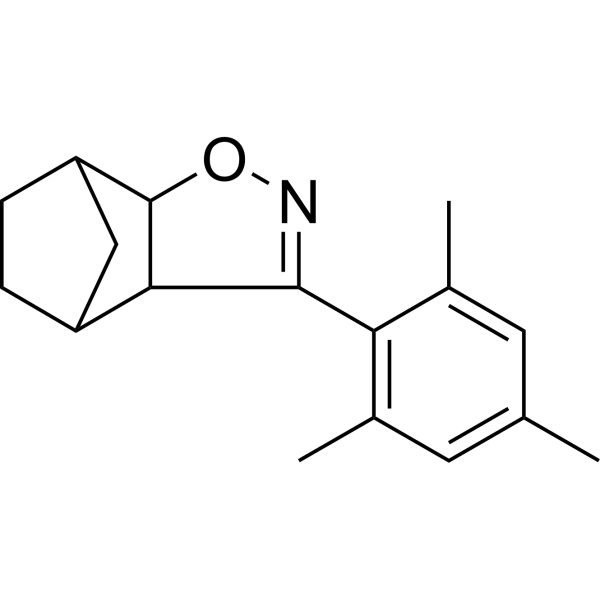
-
- HY-124314
-
|
|
MAGL
|
Metabolic Disease
|
|
LEI-106 is a potent, dual sn-1-Diacylglycerol lipase α (DAGL-α)/ABHD6 inhibitor with an IC50 of 18 nM for DAGL-α and a Ki of 0.8 μM for ABHD6. LEI-106 inhibits the hydrolysis of [ 14C]-sn-1-oleoyl-2-arachidonoyl-glycerol, the natural substrate of DAGL-α, with a Ki of 0.7 μM .
|
-
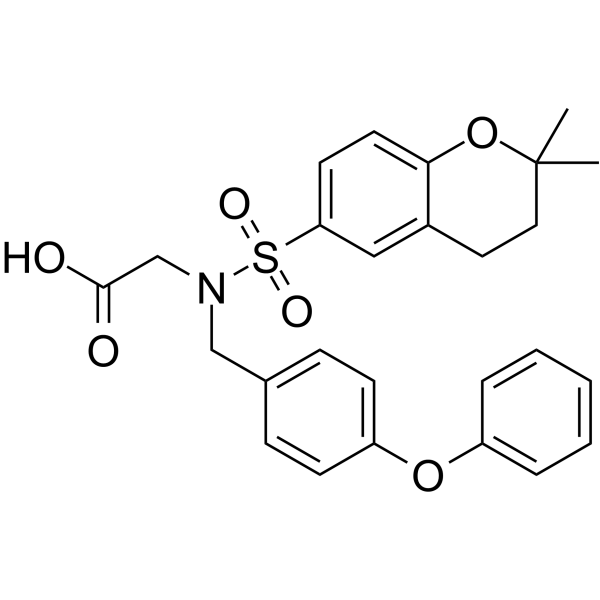
-
- HY-A0210
-
-
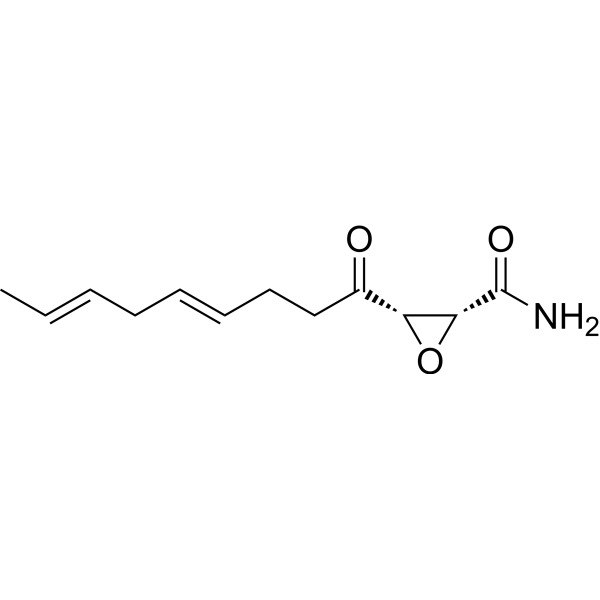
-
- HY-12757
-
|
|
BCRP
|
Cancer
|
|
YHO-13177 is a potent and specific inhibitor of BCRP; potentiated the cytotoxicity of SN-38 in cancer cells and no effect on P-glycoprotein–mediated paclitaxel resistance in MDR1-transduced human leukemia K562 cells.
|
-
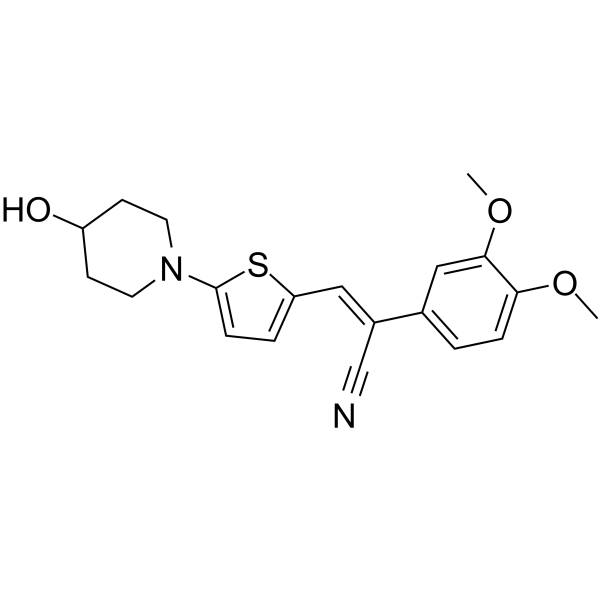
-
- HY-155034
-
|
|
Topoisomerase
GLUT
|
Cancer
|
|
Antitumor agent-102 (compound 10) is a conjugate of Topoisomerase I inhibitor SN38 and glucose transporter inhibitor, targeting to colorectal cancer. Antitumor agent-102 induces higher concentrations of free SN38 in tumor tissues than Irinotecan (HY-16562) .
|
-
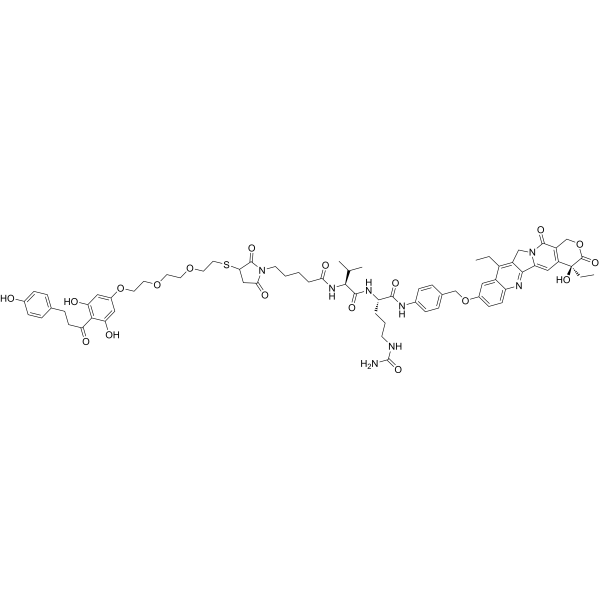
-
- HY-118442
-
|
Tetradecasphing-4-enine
|
PKC
|
Cancer
|
|
Sphingosine (d14:1) (Tetradecasphing-4-enine), a sphingolipid, is a potent Protein kinase C (PKC) inhibitor. Sphingosine (d14:1) prevents its interaction with sn-1,2-diacylglycerol (DAG)/Phorbol esters .
|
-
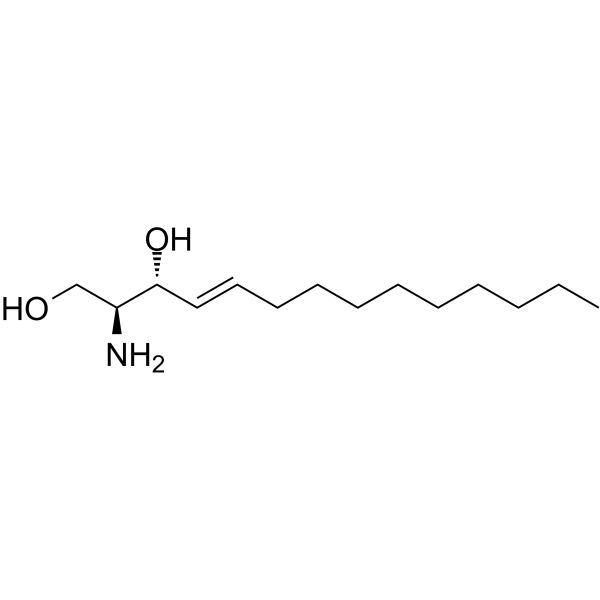
-
- HY-123849
-
|
|
PI3K
mTOR
|
Cancer
|
|
SN32976 is a potent and selective class I PI3K and mTOR inhibitor with IC50s of 15.1 nM, 461 nM, 110 nM, 134 nM and 194 nM for PI3Kα, PI3Kβ, PI3Kγ, PI3Kδ and mTOR, respectively. SN32976 shows high selectivity among other 442 kinases. SN32976 shows anticancer effects .
|
-
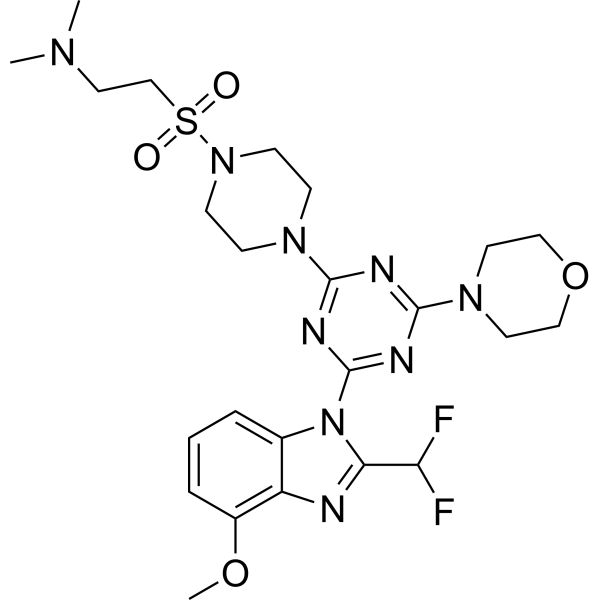
-
- HY-157647
-
|
PC(18:0/22:4)
|
CDK
Apoptosis
|
Cancer
|
|
1-Stearoyl-2-Adrenoyl-sn-glycero-3-PC (PC(18:0/22:4)) is an inhibitor of cyclin-dependent kinases (CDKs).? 1-Stearoyl-2-Adrenoyl-sn-glycero-3-PC induces apoptosis and inhibits the growth of various cancer cell lines .
|
-
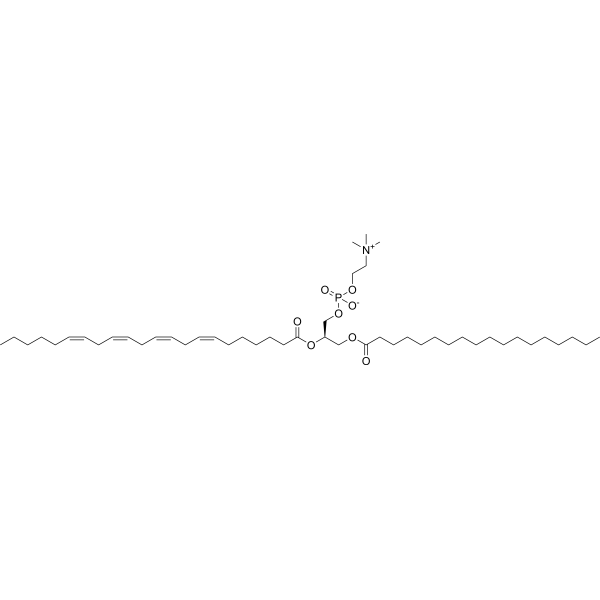
-
- HY-147071
-
|
DAPE
|
Others
|
Metabolic Disease
|
|
1,2-Diarachidonoyl-sn-glycero-3-phosphoethanolamine (DAPE) is a phospholipid phosphatidylethanolamine. Unlike other phospholipid phosphatidylethanolamines, 1,2-Diarachidonoyl-sn-glycero-3-phosphoethanolamine has no significant effect on protein phosphatase PP2A activity and does not inhibit insulin-stimulated GLUT4 translocation .
|
-

-
- HY-146241
-
|
|
EAAT
ASCT
|
Cancer
|
|
SN40 is a potent amino acid transport (AAT) inhibitor with Kis of 7.29 μM, 2.42 μM, 2.94 μM, 5.55 μM, 24.43 μM and 5.55 μM for rat ASCT2, human ASCT2, EAAT1, EAAT2, EAAC1 and EAAT5, respectively. SN40 can be used for researching anticancer .
|
-

-
- HY-146241B
-
|
|
Others
|
Others
|
|
SN40 hydrochloride is a potent amino acid transport (AAT) inhibitor with Kis of 7.29 μM, 2.42 μM, 2.94 μM, 5.55 μM, 24.43 μM and 5.55 μM for rat ASCT2, human ASCT2, EAAT1, EAAT2, EAAC1 and EAAT5, respectively. SN40 hydrochloride can be used for researching anticancer .
|
-
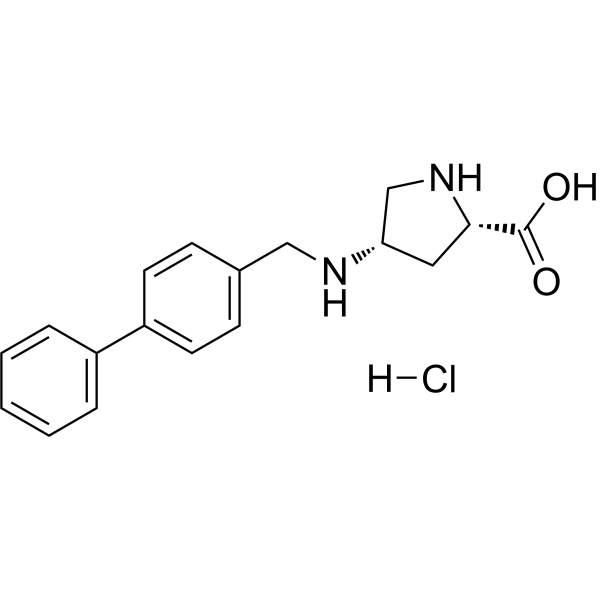
-
- HY-148044
-
|
|
Bacterial
|
Infection
|
|
UNC10201652 is a potent Loop 1 (L1)-specific gut bacterial β-glucuronidase (GUSs) inhibitor with an IC50 value of 0.117 μM for E. coli GUS. UNC10201652 can block SN-38 glucuronide (HY-126373) processing only in individuals whose fecal gut microbiota is highly abundant in L1 GUS enzymes .
|
-
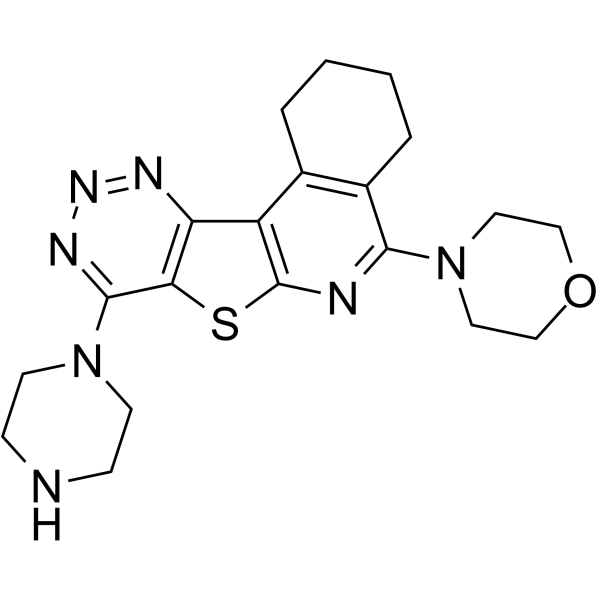
-
- HY-146242
-
|
|
EAAT
ASCT
|
Cancer
|
|
SN05 is a potent amino acid transport (AAT) inhibitor with Kis of 2.77 μM, 0.73 μM, 0.87 μM, 3.7 μM, 7.25 μM, 7.23 μM and 2.22 μM for human ASCT1, rat ASCT2, human ASCT2, EAAT1, EAAT2, EAAC1 and EAAT5, respectively. SN05 can be used for researching anticancer .
|
-
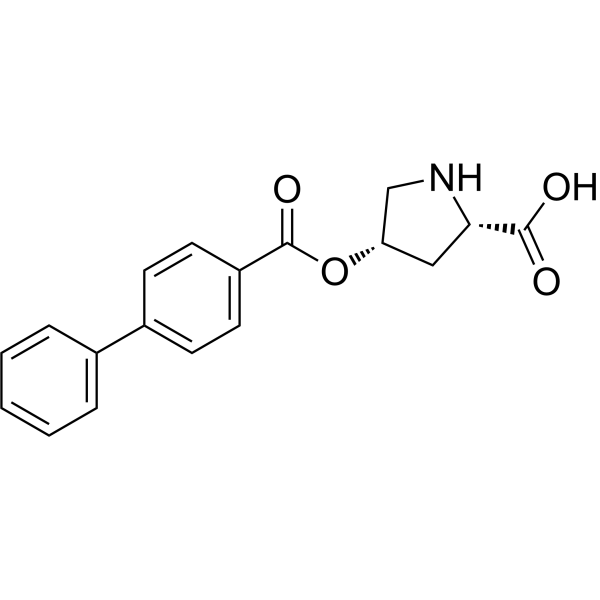
-
- HY-W127380
-
|
|
Biochemical Assay Reagents
|
Others
|
|
Arachidonoyl Thio-PC is a substrate of many phospholipase A2 (PLA2), including sPLA2, cPLA2 and iPLA2. Cleavage of sn-2 fatty acids by PLA2 results in the production of free thiols, which react with chromogenic reagents such as DTNB (Ellman's reagent) and DTP, allowing quantification of PLA2 activity. Isozyme-specific cPLA2 activity can be measured by depleting or inhibiting sPLA2 and iPLA2 activity in the assay.
|
-
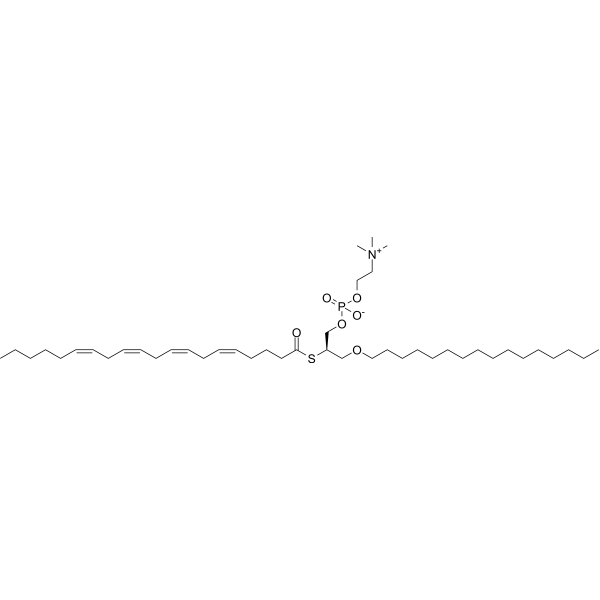
-
- HY-145384
-
|
|
Phospholipase
|
Inflammation/Immunology
|
|
ROC-0929 (compound 13a) is a potent and selective inhibitor of secreted phospholipases A2 (sPLA2s) with an IC50 of 80 nM, specially targeting hGX. ROC-0929 inhibits the phosphorylation of ERK1/2 and p-38. Secreted phospholipases A2 (sPLA2s) are a family of disulfide-rich, Ca 2+-dependent enzymes that hydrolyze the sn-2 position of glycero-phospholipids to release a fatty acid and a lysophospholipid. ROC-0929 has the potential for researching inflammation related diseases .
|
-
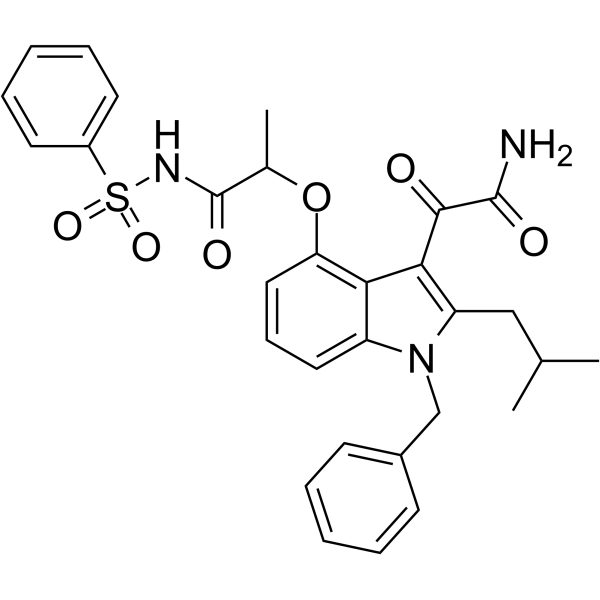
-
- HY-107658
-
SN 6
5 Publications Verification
|
Na+/Ca2+ Exchanger
|
Cardiovascular Disease
|
|
SN 6 is a selective Na +/Ca 2+ exchanger (NCX) inhibitor, and inhibits 45Ca 2+ uptake by NCX1, NCX2, and NCX3, with IC50s of 2.9, 16, and 8.6 μM, respectively.
|
-
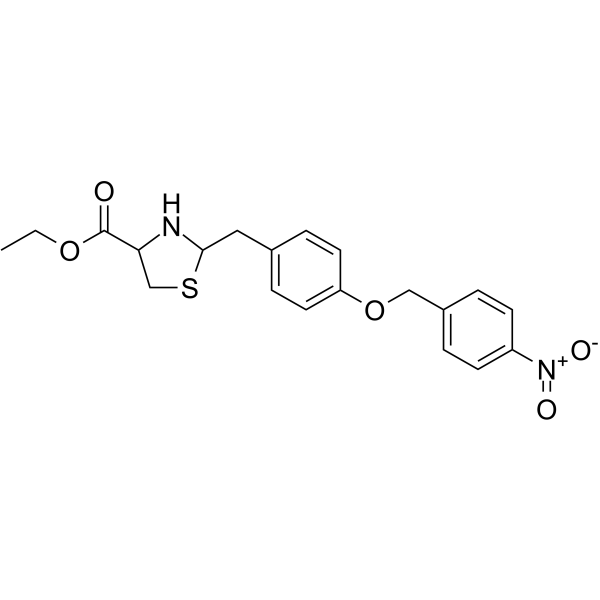
-
- HY-135845
-
|
CH0793011
|
Topoisomerase
|
Cancer
|
|
TP3011 (CH0793011) is an active metabolite of CH-0793076 and is a potent topoisomerase I inhibitor equipotent as SN38 . TP3011 is against cancer cell lines growth with IC50s at the range sub-nanomolar in vitro .
|
-

-
- HY-W251428
-
|
|
Biochemical Assay Reagents
|
Others
|
|
Phosphatidylglycerol is a naturally occurring anionic phospholipid that is a component of plant, animal and bacterial cell membranes. It is present in prokaryotes and eukaryotes less than phosphatidylethanolamine, and in eukaryotes less than phosphatidylcholine. It is formed by the reaction between CDP-diglyceride and L-α-glycerol 3-phosphate followed by dephosphorylation and is the metabolic precursor of cardiolipin. Phosphatidylglycerols containing polyunsaturated and monounsaturated fatty acyl chains inhibit and promote the proliferation of murine keratinocytes, respectively. Phosphatidylglycerol is the second-largest lipid component of mammalian lung surfactant, accounting for 10% of lipids, and has reduced levels of pulmonary surfactant in infants with respiratory distress syndrome. Phosphatidylglycerol (egg) is a mixture of phosphatidylglycerols isolated from eggs with various fatty acyl groups at the sn-1 and sn-2 positions. References: [1]. Ohtsuka, T., Nishijima, M., and Akamatsu, Y. Phosphatidylglycerol phosphate synthase-deficient somatic mutants with impaired phosphatidylglycerol and cardiolipin biosynthesis J. Biol. Chemical. 268(30), 22908-22913 (1993).[2]. Furse, S. Are phosphatidylglycerols essential for terrestrial life J. Chemistry. biology. 10(1), 1-9 (2016).[3]. Xie, D., Seremwe, M., Edwards, JG, et al. Different effects of different phosphatidylglycerols on the proliferation of mouse keratinocytes PLoS One 9(9), e107119 (2014).
|
-

-
- HY-W019868
-
|
|
Others
|
Others
|
|
1-O-Hexadecyl-2-O-acetyl-sn-glycerol is an alkyl acylglycerol that may activate the amino acid transport activity of the A-system and stimulate the absorption of methylaminoisobutyric acid (MeAIB). MeAIB inhibits mTOR phosphorylation, which may affect intestinal amino acid absorption and signal transduction .
|
-
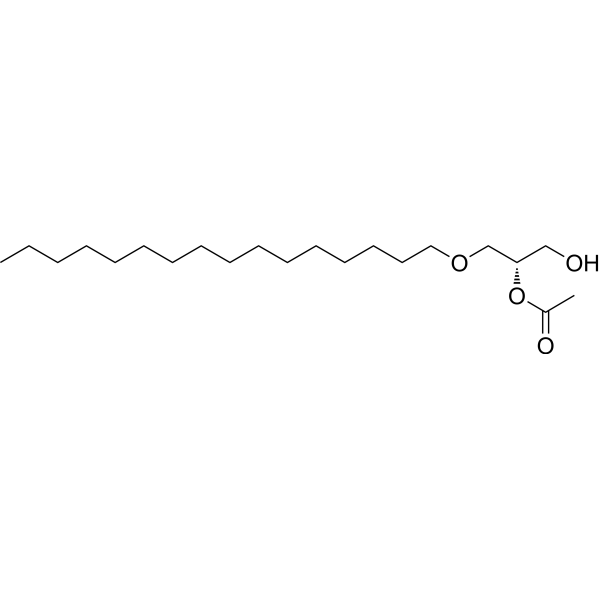
-
- HY-146725
-
|
|
FBPase
|
Metabolic Disease
|
|
FBPase-IN-1 is a potent FBPase (Fructose-1,6-bisphosphatase) inhibitor for Type 2 diabetes (T2D) study with an IC50 of 0.22 μM. FBPase-IN-1 can reduce blood glucose levels and ameliorate glucose tolerance. FBPase-IN-1 modifies the C128 site, regulates the N125-S124-S123 allosteric pathway of FBPase and affects the catalytic activity of FBPase .
|
-
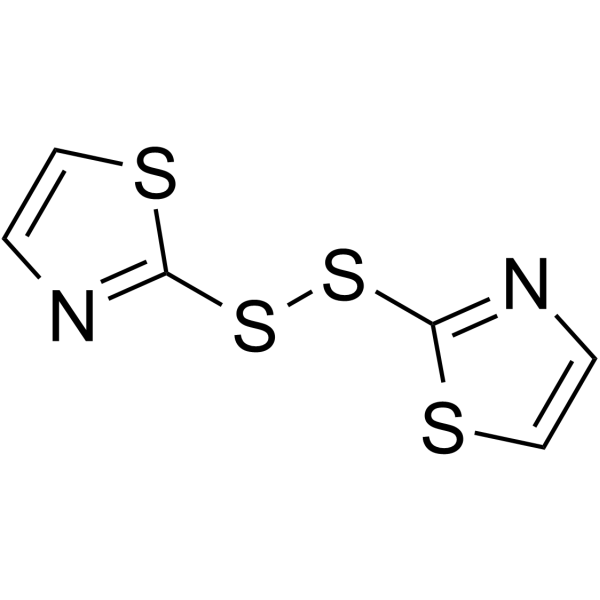
-
- HY-100195
-
|
|
|
|
|
SAR-020106 is an ATP-competitive, potent, and selective CHK1 inhibitor with an IC50 of 13.3 nM for human CHK1. SAR-020106 shows excellent selectivity over CHK2. SAR-020106 significantly enhances the cell killing of Gemcitabine and SN38 by 3- to 29-fold in several colon tumor lines and in a p53-dependent fashion. SAR-020106 can enhance antitumor activity with selected anticancer agents .
|
-
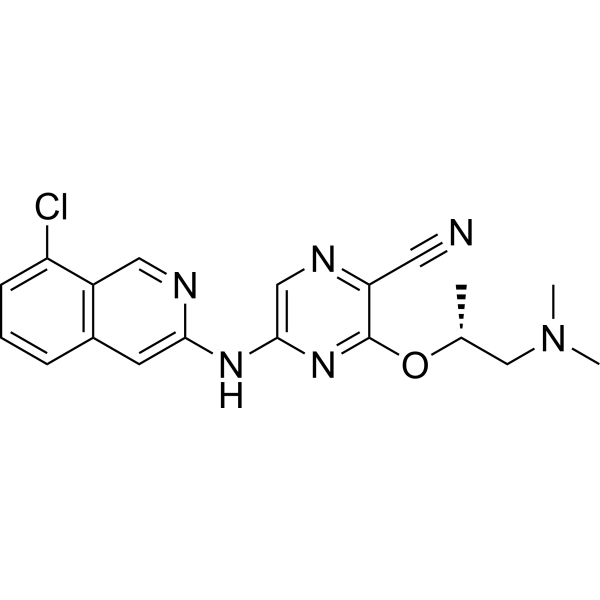
-
- HY-P5272
-
|
|
Bacterial
|
Inflammation/Immunology
|
|
Histatin-3 TFA, a 32 amino acid peptide, possesses powerful antimicrobial properties. Histatin-3 TFA behaves as a substrate for proprotein convertase 1 (PC1), being cleaved by this endoprotease primarily at a site carboxy terminal to the single Arg25 residue (HRGYR decrease SN). Histatin-3 TFA is a moderately potent, reversible and competitive inhibitor of the furin-mediated cleavage of the pentapeptide pGlu-Arg-Thr-Lys-Arg-MCA fluorogenic substrate, with an estimated inhibition constant Ki of 1.98 μM .
|
-

| Cat. No. |
Product Name |
Type |
-
- HY-W251428
-
|
|
Biochemical Assay Reagents
|
|
Phosphatidylglycerol is a naturally occurring anionic phospholipid that is a component of plant, animal and bacterial cell membranes. It is present in prokaryotes and eukaryotes less than phosphatidylethanolamine, and in eukaryotes less than phosphatidylcholine. It is formed by the reaction between CDP-diglyceride and L-α-glycerol 3-phosphate followed by dephosphorylation and is the metabolic precursor of cardiolipin. Phosphatidylglycerols containing polyunsaturated and monounsaturated fatty acyl chains inhibit and promote the proliferation of murine keratinocytes, respectively. Phosphatidylglycerol is the second-largest lipid component of mammalian lung surfactant, accounting for 10% of lipids, and has reduced levels of pulmonary surfactant in infants with respiratory distress syndrome. Phosphatidylglycerol (egg) is a mixture of phosphatidylglycerols isolated from eggs with various fatty acyl groups at the sn-1 and sn-2 positions. References: [1]. Ohtsuka, T., Nishijima, M., and Akamatsu, Y. Phosphatidylglycerol phosphate synthase-deficient somatic mutants with impaired phosphatidylglycerol and cardiolipin biosynthesis J. Biol. Chemical. 268(30), 22908-22913 (1993).[2]. Furse, S. Are phosphatidylglycerols essential for terrestrial life J. Chemistry. biology. 10(1), 1-9 (2016).[3]. Xie, D., Seremwe, M., Edwards, JG, et al. Different effects of different phosphatidylglycerols on the proliferation of mouse keratinocytes PLoS One 9(9), e107119 (2014).
|
-
- HY-W127380
-
|
|
Biochemical Assay Reagents
|
|
Arachidonoyl Thio-PC is a substrate of many phospholipase A2 (PLA2), including sPLA2, cPLA2 and iPLA2. Cleavage of sn-2 fatty acids by PLA2 results in the production of free thiols, which react with chromogenic reagents such as DTNB (Ellman's reagent) and DTP, allowing quantification of PLA2 activity. Isozyme-specific cPLA2 activity can be measured by depleting or inhibiting sPLA2 and iPLA2 activity in the assay.
|
| Cat. No. |
Product Name |
Target |
Research Area |
-
- HY-P3229
-
SN52
1 Publications Verification
|
NF-κB
|
Cancer
|
|
SN52 is a potent, competitive, and cell-permeable inhibitor of NF-κB2. SN52 is a variant of the SN50 peptide and inhibits the nuclear translocation of p52-RelB heterodimers. SN52 has a strong radiosensitization effect on prostate cancer cells. SN52 can be used for cancer research .
|
-
- HY-P0151
-
-
- HY-P5272
-
|
|
Bacterial
|
Inflammation/Immunology
|
|
Histatin-3 TFA, a 32 amino acid peptide, possesses powerful antimicrobial properties. Histatin-3 TFA behaves as a substrate for proprotein convertase 1 (PC1), being cleaved by this endoprotease primarily at a site carboxy terminal to the single Arg25 residue (HRGYR decrease SN). Histatin-3 TFA is a moderately potent, reversible and competitive inhibitor of the furin-mediated cleavage of the pentapeptide pGlu-Arg-Thr-Lys-Arg-MCA fluorogenic substrate, with an estimated inhibition constant Ki of 1.98 μM .
|
-
- HY-P10053
-
|
|
Peptides
|
Metabolic Disease
|
|
sPLA2-IIA Inhibitor is a cyclic pentapeptide analog of FLSYK (cyclic 2-Nal-Leu-Ser-2-Nal-Arg (c2)), that binds to hGIIA (human IIA phospholipase A2) and inhibits its hydrolytic ability. sPLA2 is a member of the esterase superfamily that catalyzes the hydrolysis of the ester bond at the sn-2 position of glycerophospholipids, releasing free fatty acids such as arachidonic acid and lysophospholipids .
|
| Cat. No. |
Product Name |
Category |
Target |
Chemical Structure |
| Cat. No. |
Product Name |
Chemical Structure |
-
- HY-13704S
-
|
|
|
SN-38-d3 is the deuterium labeled SN-38. SN-38 (NK012) is an active metabolite of the Topoisomerase I inhibitor Irinotecan. SN-38 (NK012) inhibits DNA and RNA synthesis with IC50s of 0.077 and 1.3 μM, respectively[1][2][3][4].
|
-

-
- HY-126373S1
-
|
|
|
SN-38 glucuronide- 13C6 is the 13C labeled SN-38 glucuronide (HY-126373) . SN-38 glucuronide is an inactive metabolite of the cancer agent Irinotecan. Irinotecan is a topoisomerase I inhibitor which can be used for researching colon and rectal cancer .
|
-

Your information is safe with us. * Required Fields.
Inquiry Information
- Product Name:
- Cat. No.:
- Quantity:
- MCE Japan Authorized Agent:

















































